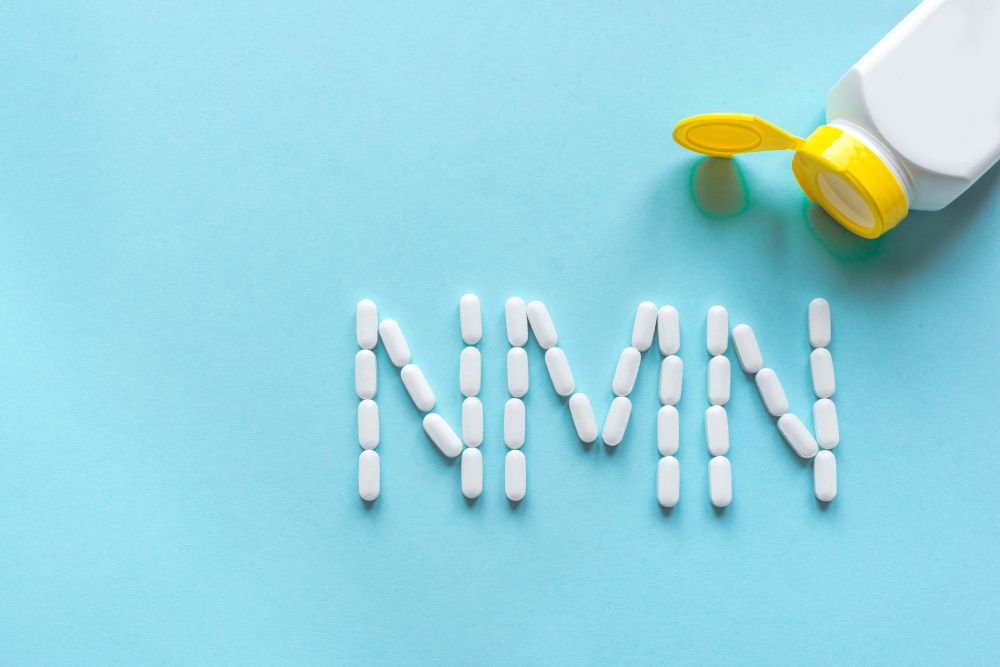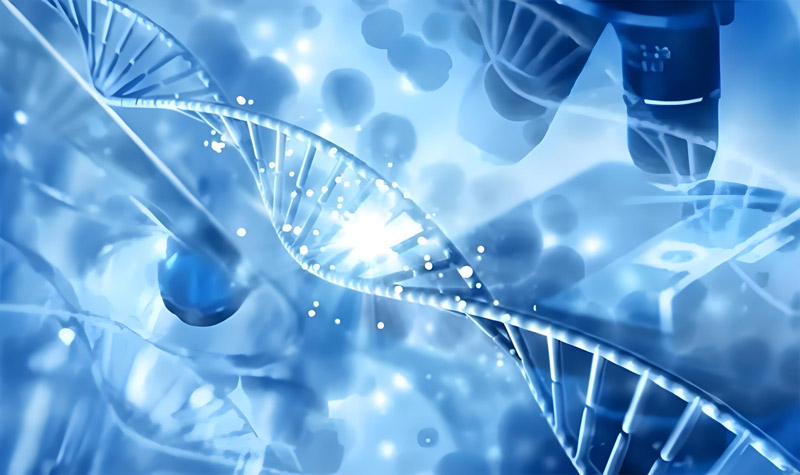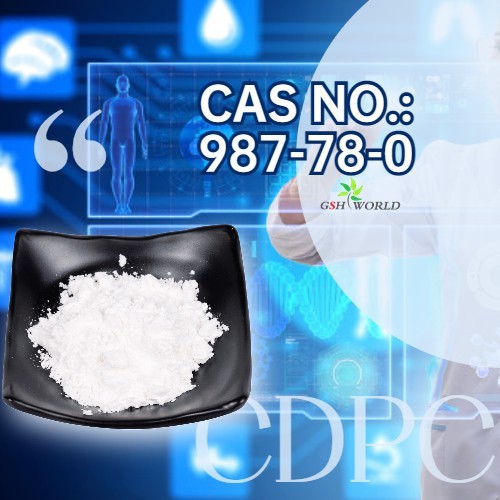1. Abstract
Nicotinamide mononucleotide (NMN), a key precursor of NAD+, has emerged as a promising nutritional supplement due to its excellent efficacy in alleviating aging and disease.
The biological production of NMN faces the challenge of incomplete metabolic engineering and insufficient metabolic flux.
In this study, the NMN synthesis pathway was constructed in Escherichia coli BW25113 by deleting competing pathway genes and introducing three heterogenic genes encoding the key enzymes nicotinamide phosphoribosyl transferase (NAMPT), phosphoribosyl pyrophosphate synthetase and NMN transporter.
Next, the highly active NAMPT was identified and the gene expression was optimized, which significantly increased the conversion of NAM to NMN, and the titer in the shaker reached 3503.85mg/L.
By promoting the coupling of glucose and xylose, more metabolic flux was transferred to PRPP biosynthesis, and a NMN titer of 15.66 g/L was obtained by whole cell catalysis, compared to 46.66 g/L in a 2-liter bioreactor.
This is the highest NMN production reported to date and shows the huge potential to kick-start sustainable industrial production of NMN.
2. Background
β-nicotinamide mononucleotide (NMN) is an important intermediate in the biosynthesis of nicotinamide adenine dinucleotide (NAD+) and plays an indispensable role in the maintenance of cellular energy metabolism and REDOX homeostasis.
Studies have shown that NMN supplementation can effectively restore NAD+ levels, thereby activating deacetylase and other NAD+ dependent enzymes that are critical for promoting cell longevity, DNA repair, and anti-stress response.
As a promising nutritional supplement, NMN has recently attracted a lot of attention due to its excellent efficacy in delaying aging and diseases.
NMN biosynthesis pathway mainly includes de novo synthesis pathway and remediation pathway.
In de novo synthesis, niacin mononucleotide (NAMN) is aminated to NMN by NMN synthase (FtNadE).
In the remedial pathway, NMN is produced by the precursors niacinamide riboside (NR) and ATP via niacin riboside kinase, or by phosphoribosyl transferase (NAMPT) from niacinamide (NAM) and 5-phosphoribosyl-1-pyrophosphate (PRPP).
Due to the low cost, wide availability and biosafety of NAM, its derivative pathway has become the main pathway for NMN synthesis.
Given that NAMPT is the rate-limiting enzyme in this pathway, it is necessary to screen highly active candidates for efficient NMN synthesis.
Marinescu et al. first overexpressed the NAMPT enzyme of Haemophilus ducreae in Escherichia coli and obtained NMN production of 15.42mg/L. Huang et al. increased the NMN concentration to 16.2 g/L in a 5-L bioreactor by overexpressing NAMPT of Vibrio phage KVP40 (VpNampt).
PRPP is a key precursor of NMN synthesis and is primarily produced by glucose via the pentose phosphate pathway (PPP).
Previous studies have explored enhancing the metabolic flux from glucose to PRPP to promote PRPP synthesis, but did not significantly increase the production of compounds with PRPP as a precursor, and instead impaired the growth of strains.
PRPP can also be synthesized from xylose. The coupling of glucose and xylose can balance metabolic flow distribution and enable the production of a variety of economically viable compounds.
Due to low expression levels of carbon catabolic inhibition (CCR) and xylose metabolism-related genes, most microorganisms, including E. coli, cannot utilize xylose efficiently.
Previous studies have improved the efficiency of glucose and xylose coupling by disrupting the phosphotransferase system (PTS) to reduce the CCR effect, overexpressing xylose-specific transporters XylE and XylFGH to enhance xylose transport, and modifying the xylose-specific activator XylR responsible for xylAB and xylFGH expression.
By utilizing glucose and xylose simultaneously, the carbon flux supplied by PRPP can be increased, thereby improving the biosynthesis of NMN.
The production of NMN has been greatly improved through the transformation of metabolic engineering, but further research is needed to realize the industrial production of NMN.
The aim of this study was to further increase the production of NMN by screening highly active NAMPT and increasing the supply of PRPP through the coupling of glucose and xylose.
The engineered E. coli strain was able to produce 46.66 g/L of NMN in a 2-L bioreacter, which is the highest NMN yield reported to date.

3. Results
(1). Construction of basic Escherichia coli strains for NMN synthesis
The current classical pathway of NMN biosynthesis utilizes NAM and PRPP as precursors and is catalyzed by NAMPT.
The NMN biosynthetic pathway and its regulatory mechanism in E. coli are shown in Figure 1.
C. pennensis (CpNampt) was selected for its high enzymatic activity.
In Bacillus subtilis, the PRPP synthetic pathway showed strong activity.
Using CpNampt and PRPP synthetase (BsPRS) of Bacillus subtilis, a BAD-CpNAMpt-BSPRS plasmid driven by arabinose promoter was constructed, which synthesizes NMN from NAM and glucose in E. coli BW25113.
No NMN production was detected, suggesting that some competing pathways may inhibit NMN synthesis.
We knocked out pncC, nadR and ushA genes to increase the production of NMN.
The ushA isoenzyme genes umpG and umpH also need to be knocked out.
In order to ensure the specific and consistent supply of NMN synthetic substrates, NAM degrading gene pncA must also be knocked out.
With the successive knockout of the above six genes, extracellular production of NMN in the flask reached a titer of 160.66mg/L.
Large amounts of intracellular NMN were still detected in strain NMN004, suggesting that the natural NMN transporter in E. coli is insufficient to support NMN secretion.
In order to enhance the transport of NMN to the extracellular matrix, the well-characterized effector transporter PnuC was overexpressed in strain NMN004, resulting in the engineered strain NMN005-Cp.
As shown in Figure 2B, overexpression of PnuC (BmPnuC) from B. mycoides significantly increased extracellular NMN production to a titer of 416.67 mg/L.
The authors also tried to express the reported NiapBC transporter from Penicillium, namely NAM transporter, to increase the uptake of NAM. However, the effect on NMN production was not significant.
This difference may be due to genetic differences between E. coli BL21 (DE3) and E. coli BW25113, which may affect the expression and function of Niap-BC and NMN.

metabolic engineering modification of NMN production. (A) Effect of deletion of competing pathway genes on NMN synthesis. (B) Effect of NMN transporter BmPnuC on NMN synthesis.
(2). Identification of a highly active NAMPT enzyme
In order to achieve effective transformation of NAM to NMN, it is important to screen highly active NAMPT.
The authors screened and identified 16 NAMPT enzymes, including HdNampt from H. ducreyi, 12 CpNampt from C. pinensis, 13 HuNampt from H. sapiens28 and VpNampt from V. phage KVP40.
NAMPT's kcat analysis showed that VniNampt from Vibrio nigripulchritudo had a relatively high affinity for both PRPP and NAM.
Consistent with kcat predictions, VniNampt showed the highest efficiency (823.07 mg/L) in catalytic conversion of NAM to NMN.
VniNampt was selected for further experiments to optimize the biosynthesis of NMN.
Notably, although VpNamp had significantly lower kcat values for PRPP and NAM than VniNampt, the NMN production levels produced were very similar.
This result was mainly attributed to the high expression level of VpNampt protein.
This observation underscores the importance of combining kcat predictions with protein expression levels in specific host cells.

(A) Phylogenetic likelihood trees for 16 candidate amino acid sequences and kcat (s-1) values for PRPP (blue bar) and NAM (red bar) predicted by DLkcat. (B) The efficiency of various overexpressed NAMPTs in producing NMN in E. coli.
(3) Optimization of key gene expression models
The expression of allogenic genes in E. coli is crucial for the synthesis of target products.
Therefore, the authors further optimized the expression patterns of genes associated with the NMN biosynthetic pathway.
When VniNampt and BsPrs were co-expressed with BmPnuC by arabinose promoter (NMN006) and T5 promoter (NMN007), respectively, NMN production increased slightly to different degrees.
Obviously, when BmPnuC was expressed on a single high copy plasmid (NMN008), its ability to synthesize NMN was the highest, and the yield reached 3503.85 mg/L in shaker, which was 325.70% higher than that of engineered strain NMN005-Vni.
In addition, it had no negative effect on final cell density. The results showed that increasing the plasmid copy number of the transporter further enhanced gene expression.
However, it should be noted that the level of transcription of BmPnuC is not fully correlated with the production of NMN.
The increase in NMN production may be the result of co-optimized (or coordinated) expression of the three genes (VniNampt, BsPrs, and BmPnuC), rather than the result of BmPnuC expression alone.

(4) Increase xylose utilization rate to increase NMN yield
As a key precursor of NMN synthesis, PRPP plays an important role in the synthesis of NMN.
In order to improve the supply of PRPP, the key genes of PRPP pathway (zwf and gnd) were overexpressed.
When glucose was fed as the only carbon source, overexpression of these genes did not increase the production of NMN, but caused damage to bacterial growth.
Considering that xylose metabolizes to PRPP by a shorter pathway than glucose, the authors sought to enhance xylose utilization in order to increase the supply of PRPP in E. coli.
By increasing the metabolic flux of xylose, it is possible to increase the production of NMN by increasing the availability of PRPP.
First, in order to alleviate CCR and improve the glucose-xylose linking rate, the author destroyed ptsG gene encoding glucose-specific PTS enzyme II component and overexpressed glk gene encoding glucokinase to restore glucose utilization through non-PTS pathway in order to promote xylose transport. At the same time, xylose transporters (XylE and XylFGH) were overexpressed, and the engineered strains NMN009 and NMN010 were obtained, respectively.
For whole cell catalysis, when 10 g/L xylose was used as the only carbon source for NMN synthesis, strain NMN010 showed higher xylose transport efficiency and NMN synthesis ability, producing 4.46 g/L of NMN and 1.09 g/L of xylose after conversion for 24 h.
To increase the metabolic flux of xylose, Sievert et al. developed XylR mutants R121C and P363S, which increased the transcription levels of xylAB and xylFGH by 20 and 10 times, respectively.
Therefore, based on NMN010, strain NMN011 was constructed by overexpressing the transcriptional activator XylR*(XylRR121C).
After 24 h of whole-cell catalysis of xylose (final concentration of 10 g/L) as the sole carbon source, NMN011 fully utilized xylose and produced 7.27 g/L of NMN.
This is the highest NMN production of xylose and NAM reported to date.
When glucose with a final concentration of 20 g/L was used as the only carbon source, the yield of NMN was 12.15 g/L.
After examining the performance of strain NMN011 under a single carbon source, the authors further investigated the production of NMN under the mixed condition of 10 g/L glucose and 10 g/L xylose.
The results showed that NMN011 could utilize both glucose and xylose simultaneously, consuming 9.73 g/L glucose and 9.9 g/L xylose, and producing 15.66 g/L NMN.

(A) Comparison of whole cell catalytic synthesis of NMN by engineered strains using xylose as the only carbon source. (B) Xylose consumption in whole-cell catalysis where xylose is the only carbon source. (C) NMN yield under different carbon sources. (D) Glucose and xylose consumption.
(5) NMN is produced by high density fermentation
To assess the potential of engineered E. coli strain NMN011 for industrial production of NMN, high-density fermentation was performed in a 2-liter tank fermenter using a feed-batch strategy with different carbon sources.
Feed continuously at the speed of 0.4 ~ 0.6g /L/h. When glucose was used as the only carbon source (fermenter A), NMN production reached 26.07 g/L after 72 h.
When glucose and xylose were used as complex carbon sources, that is, 10 g/L xylose (fermenter B) and 20 g/L xylose (fermenter C) were fed during the whole fermentation process, the yield of NMN was significantly increased.
Especially when the xylose concentration is 20 g/L, the NMN titer is 46.66 g/L.
The fermentation results showed that the NMN yield of NMN011 increased rapidly within 24 ~ 48 h, but decreased after 48 h, which may be related to the decrease of biomass.
This effect is particularly evident in the medium where glucose is the only carbon source.
This may be due to the fact that PRPP is a common precursor of several intracellular metabolic pathways, such as thiamine, histidine, tryptophan, and nucleotide metabolism, and PRPP deficiency may impair cell development and metabolism.
In addition, xylose utilization increases the biosynthesis of PRPP, but requires more ATP consumption compared to glucose, resulting in slower cell growth.

(A) Glucose NMN fermentation. (B) Adding 10 g/L xylose fermentation to produce NMN. (C) Adding 20 g/L xylose fermentation to produce NMN. The black arrows indicate the expression of arabinose and lactose induced proteins. The red arrow indicates the beginning of the transformation.
conclusion
In summary, this study developed a method for the production of NMN from glucose and xylose through systemic metabolic engineering of Escherichia coli, which includes:
(1) Build an efficient NMN production base,
(2) Introduce the newly discovered highly active NAMPT,
(3) Increase the supply of PRPP by strengthening the coupling of glucose and xylose.
The optimized strain had an NMN titer of 46.66 g/L in 2-L bioreactor.
This is the highest NMN production reported to date.
This is the first example of glucose and xylose coupling to produce NMN, which establishes a new strategy for NMN synthesis and provides a reference for the production of value-added compounds at high levels using PRPP as a precursor.
Original link: https://doi.org/10.1021/acs.jafc.4c10205






